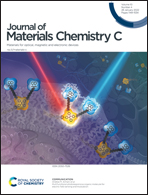MFC-driven H2S electro-oxidation based on Fe nanoparticles anchored on carbon aerogel-ZIF-8: a combined experimental and DFT study†
Abstract
Electrocatalysts for the electrochemical oxidation of hydrogen sulfide (H2S) to elemental sulfur and its recovery in the form of sulfur, particularly catalysts based on metal–organic-framework (MOF) supports, have been widely investigated. However, energy saving during the electrochemical oxidation of H2S, the formation of a catalyst with superb conductivity and stability by protecting a zeolitic imidazolate framework-8 (ZIF-8) from being destroyed during synthesis, and the prevention of Fe sites from deactivation are still challenging tasks. Herein, an effective strategy to improve the crystalline structure and enhance the porosity/surface area of ZIF-8 with poor crystallinity by the induced growth of a carbon aerogel (CA)-ZIF-8 on a mixed-metal metal–organic framework (MM-MOF) template with good crystallinity and optimized Fe nanoparticle doping content (1, 3, and 5 wt%) is described. Moreover, a microbial fuel cell (MFC) with different cathode catalysts was started up and operated to provide the electrical energy to drive the electrocatalytic removal of H2S. Through open-circuit voltage (OCV) and anodic polarization measurements at 0.2, 0.5, and 0.7 V vs. the standard hydrogen electrode (SHE), the Fe-doped CAs-ZIF-8@MM-MOF (1 wt%) exhibits excellent electro-catalytic activity (8.12 ± 0.11 h−1 at 0.7 V vs. SHE) compared to a pristine carbon cloth (CC) electrode (1.13 ± 0.24 h−1 at 0.7 V vs. SHE). According to surface characterization and density functional theory (DFT) calculation results, it is worth noting that the introduction of a low loading of Fe nanoparticles into a catalyst support prefers to occupy an Fe–N4 configuration rather than an M–Fe–M (C) configuration. The Fe–N4 active centers favor the adsorption and association/dissociation of H2S. In contrast, the M–Fe–M (C) centers are more favorable for strengthening the bonding between the Fe nanoparticles and the support.



 Please wait while we load your content...
Please wait while we load your content...